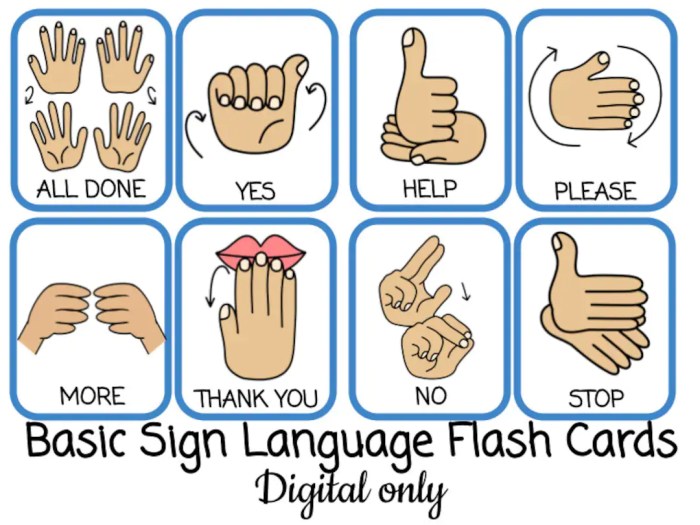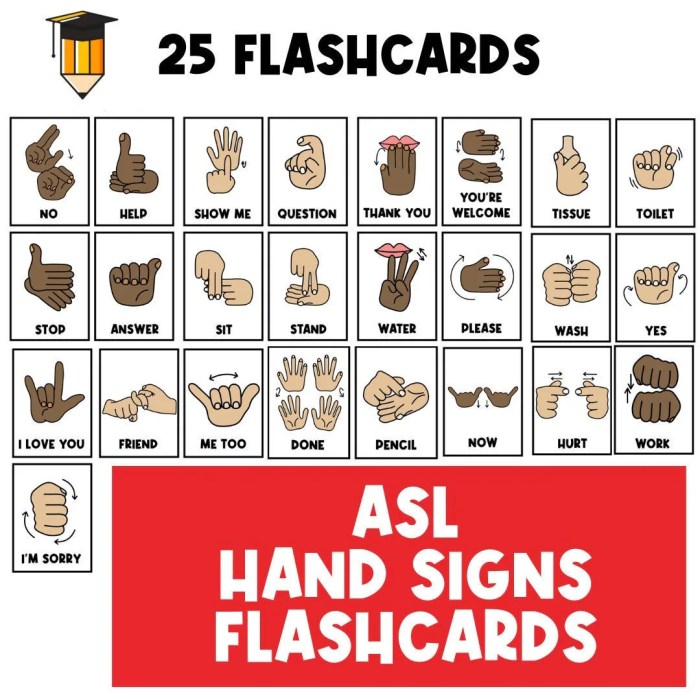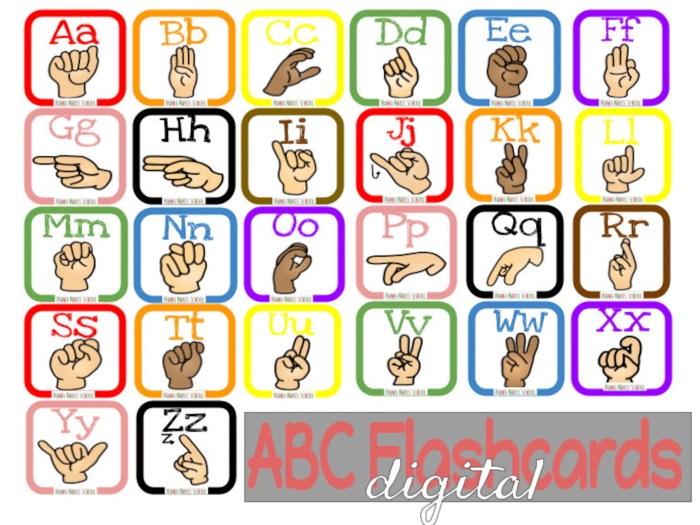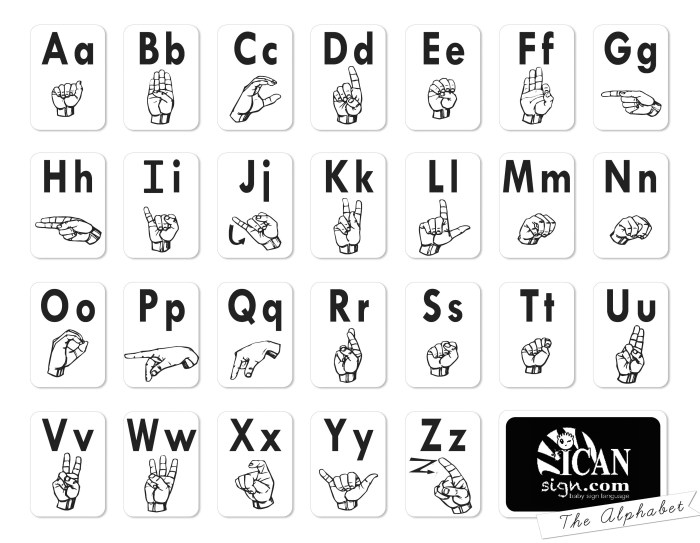ASL sign language flash cards are an invaluable tool for learning and improving your ASL skills. They provide a convenient and portable way to practice signing, expand your vocabulary, and enhance your comprehension.
From beginners to experienced signers, ASL sign language flash cards cater to all levels of proficiency. They come in various formats, from traditional paper cards to interactive digital apps, offering flexibility and accessibility.
Introduction to ASL Sign Language Flash Cards
American Sign Language (ASL) sign language flash cards are a valuable tool for learning and practicing ASL. They provide a convenient and portable way to review vocabulary and improve your signing skills.
ASL sign language flash cards typically include an image or video of a sign on one side and the corresponding word or phrase on the other. They can be used for self-study, as a supplement to ASL classes, or as a fun way to improve your signing skills.
Benefits of Using ASL Sign Language Flash Cards
Using ASL sign language flash cards offers several benefits:
- Improved Vocabulary:Flash cards help you expand your ASL vocabulary by exposing you to new signs and phrases.
- Enhanced Retention:The act of reviewing flash cards helps reinforce learning and improves memory retention.
- Increased Fluency:Regular practice with flash cards can help you become more fluent in ASL, improving your signing speed and accuracy.
- Convenient Learning:Flash cards are portable and easy to use, allowing you to learn ASL anytime, anywhere.
- Fun and Engaging:Learning with flash cards can be a fun and engaging way to improve your ASL skills.
Types of ASL Sign Language Flash Cards

ASL sign language flash cards are a valuable tool for learning and practicing American Sign Language (ASL). They come in various types, each with its own advantages and disadvantages.
Physical Flash Cards
Physical flash cards are traditional cards made of paper or cardstock with the sign on one side and the English word or phrase on the other. They are tangible and easy to handle, making them a convenient option for studying on the go.
Advantages:
- Portable and accessible
- Provide a tactile learning experience
Disadvantages:
- Can be bulky to carry in large quantities
- Susceptible to wear and tear
Digital Flash Cards, Asl sign language flash cards
Digital flash cards are electronic versions of physical cards, accessible on devices like smartphones, tablets, or computers. They offer interactive features and customization options.
Advantages:
- Easily portable and accessible
- Interactive features enhance learning (e.g., voiceovers, quizzes)
- Customization options allow for personalized learning
Disadvantages:
- Require a device and internet connection
- May not provide the same tactile experience as physical cards
Video Flash Cards
Video flash cards incorporate video clips of the sign being performed. This provides a visual representation of the sign, which can be particularly helpful for beginners.
Advantages:
- Provide a clear visual representation of the sign
- Can capture nuances and expressions that may be missed in still images
Disadvantages:
- May require more data storage and bandwidth
- Can be more time-consuming to create than other types of flash cards
Categorized Flash Cards
Categorized flash cards group signs by theme or topic (e.g., animals, food, verbs). This organization can make it easier to learn related signs and build vocabulary.
Advantages:
- Promote contextual learning
- Help learners build a comprehensive vocabulary
Disadvantages:
- May require more flash cards to cover a wide range of topics
- Can be limiting if learners want to study signs outside of the categories
How to Use ASL Sign Language Flash Cards Effectively
To effectively utilize ASL sign language flash cards, consider the following best practices:
1. Regular Practice:Consistency is key. Set aside dedicated time each day to review the cards, even for short intervals.
2. Active Recall:Engage your memory by actively trying to recall the sign from the image without peeking. This strengthens your retention.
3. Multiple Senses:Involve multiple senses by saying the sign aloud while visualizing its execution. This multisensory approach enhances comprehension.
4. Spaced Repetition:Review the cards at increasing intervals (e.g., 10 minutes, 1 hour, 1 day) to reinforce learning and prevent forgetting.
5. Gamification:Make learning fun by incorporating games or challenges into your study sessions. This keeps you engaged and motivated.
6. Seek Feedback:Find a partner or tutor to provide feedback on your signing. Constructive criticism helps you refine your technique and improve accuracy.
Creating Custom ASL Sign Language Flash Cards
Creating your own ASL sign language flash cards allows you to tailor your learning experience to your specific needs. Here’s a step-by-step guide:
Selecting Signs
Choose signs that are relevant to your communication goals and interests. Consider your current skill level and focus on signs that you want to master or review.
Designing the Cards
Design your cards to be visually appealing and easy to understand. Use clear, high-quality images or videos of the signs. Write the sign name below the image and consider adding a brief description or example of how the sign is used.
Organizing the Deck
Organize your cards logically to facilitate learning. Group them by theme, such as animals, food, or emotions. You can also categorize them by difficulty level or frequency of use.
Technology and ASL Sign Language Flash Cards

In the realm of education and language learning, technology has become an invaluable ally, enhancing the efficacy of traditional methods. ASL sign language flash cards, once limited to physical decks, have now embraced the digital age, unlocking a plethora of benefits for learners.
Mobile applications and online platforms have revolutionized the way we interact with flash cards. These platforms offer an immersive and interactive experience, featuring multimedia content such as videos, animations, and interactive exercises. The convenience of accessing flash cards on-the-go makes learning more accessible and flexible.
Mobile Applications
Mobile apps provide a portable and personalized learning experience. Users can download apps tailored to their specific needs, whether they are beginners seeking to establish a foundation or advanced learners seeking to expand their vocabulary. These apps often incorporate gamification elements, making the learning process more engaging and enjoyable.
Online Platforms
Online platforms offer a wider selection of flash cards and resources, allowing users to access a vast repository of content. These platforms often feature community forums and discussion boards, where learners can connect with others, share tips, and engage in collaborative learning.
Asl sign language flash cards are a great way to learn sign language, but what if you need to transpose rx minus to plus? Luckily, there’s a simple trick you can use. Just head over to this website and follow the instructions.
Once you’ve done that, you’ll be able to easily transpose rx minus to plus. Then you can get back to learning sign language with your asl sign language flash cards.
Other Resources
Beyond mobile apps and online platforms, technology also provides a range of other resources that can enhance the use of ASL sign language flash cards. These include:
- Digital dictionaries:Provide quick and easy access to definitions and video demonstrations of signs.
- Online courses:Offer structured learning paths and interactive lessons.
- Video conferencing:Enables learners to connect with sign language tutors or peers for real-time practice.
Applications of ASL Sign Language Flash Cards

ASL sign language flash cards have a wide range of applications, proving to be valuable resources in various settings.
In educational environments, these flash cards serve as effective tools for students learning ASL. They provide visual and interactive support, making it easier to memorize and retain vocabulary. Educators can incorporate flash cards into lessons, games, and activities, enhancing the learning process and fostering a deeper understanding of ASL.
Healthcare
Within the healthcare sector, ASL sign language flash cards play a crucial role in facilitating communication between healthcare providers and deaf or hard of hearing patients. They enable medical professionals to convey important information, instructions, and emotional support, ensuring effective and compassionate patient care.
Flash cards can also help patients express their needs, concerns, and preferences, promoting better understanding and empowering them to actively participate in their healthcare decisions.
Community Outreach Programs
Community outreach programs leverage ASL sign language flash cards to connect with and empower deaf and hard of hearing individuals. These programs utilize flash cards in workshops, events, and community gatherings to promote ASL awareness, teach basic signs, and foster inclusivity.
By making ASL more accessible, community outreach programs break down communication barriers, enabling deaf and hard of hearing people to engage fully in social activities and community life.
Resources for ASL Sign Language Flash Cards

Accessing ASL sign language flash cards is crucial for effective learning. Numerous resources provide these materials, catering to diverse needs and preferences.
Online platforms offer a vast selection of flash cards. Websites like SignSchool, HandSpeak, and ASL Pro offer interactive and comprehensive resources for beginners and advanced learners alike.
Books and Publications
Printed flash cards remain a valuable resource for tactile learners. Books such as “ASL Flash Cards: The Complete Set” by I. King Jordan and “Signing Naturally Flash Cards” by Cheri Smith provide convenient and portable options for practice.
Organizations and Institutions
Deaf organizations and educational institutions often offer ASL flash cards as part of their educational programs. The National Association of the Deaf (NAD) and Gallaudet University provide resources and materials for sign language learning.
Other Resources
Additional resources include mobile applications like “ASL Dictionary” and “ASL Flashcards” that provide interactive and on-the-go learning experiences. Social media platforms like YouTube and Instagram also feature videos and content showcasing ASL signs.
FAQ Overview
What are the benefits of using ASL sign language flash cards?
ASL sign language flash cards offer several advantages, including improved vocabulary, enhanced comprehension, increased confidence, and portability.
How do I create custom ASL sign language flash cards?
Creating custom flash cards allows you to tailor your learning experience. Choose signs that are relevant to your interests or needs, design the cards with clear visuals and concise descriptions, and organize them in a logical order.
Where can I find ASL sign language flash cards?
There are numerous resources available for ASL sign language flash cards. You can find them online, in bookstores, and through organizations dedicated to Deaf education.